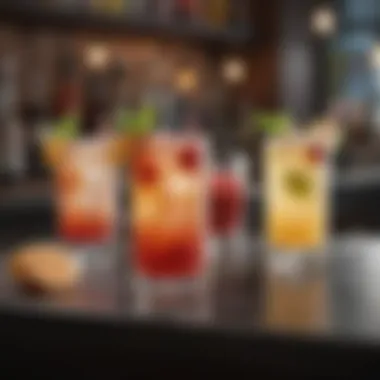Mastering the Art of Non-Alcoholic Drink Orders


Intro
The trend towards non-alcoholic beverages is gaining momentum, resonating with diverse audiences. Whether it is for health reasons, personal choice, or cultural perspectives, many prefer to skip alcoholic drinks at social events. This shift is not just a mere trend; it reflects broader changes in society's approach to consumption and wellness. Understanding how to navigate drink orders in various settings can enhance social interactions while also catering to personal preferences.
Recipe Overview
In the realm of non-alcoholic beverages, there is a spectrum of choices that broaden the palate and elevate the experience. From sparkling waters infused with natural flavors to intricate mocktails that mimic traditional cocktails, variety is abundant.
Dish Description
The concept of a non-alcoholic drink, often referred to as a mocktail or virgin beverage, encompasses an array of options that are both sophisticated and flavorful. Mocktails can have complex combinations of fruits, herbs, syrups, and spices, allowing for a rich tasting journey that satisfies the senses without any alcoholic content.
Ingredients List
When selecting or ordering a non-alcoholic drink, consider the following common ingredients:
- Fresh fruits (e.g., citrus, berries, mango)
- Fresh herbs (e.g., mint, basil, rosemary)
- Juices (e.g., orange, cranberry, pomegranate)
- Sparkling waters or tonic
- Syrups (e.g., grenadine, lavender, ginger)
- Other flavorings (e.g., bitters, soda)
Step-by-Step Instructions
Ordering a non-alcoholic drink can be a simple yet enjoyable process if approached thoughtfully. Here are several steps to consider:
Preparation Steps
- Know Your Preferences: Think about flavors you enjoy. Are you drawn to citrus, sweet, or herbal notes? Knowing your inclinations aids in making an informed choice.
- Research Options: Familiarize yourself with the drink list beforehand if possible. Many establishments provide their menus online. This knowledge can streamline your ordering process.
- Read Descriptions: When perusing a drink menu, pay attention to the details about each item. Descriptions often highlight ingredient pairings and flavor profiles.
Communicating Your Choices
- Be Direct: Politely inform the server that you are looking for a non-alcoholic option. This ensures clarity and helps them to assist you better.
- Ask Questions: Inquire about specific ingredients or flavor notes in drinks. This will guide you to selections that align with your tastes.
- Request Customization: If a drink appeals to you but includes an alcohol component, ask if it can be made without. Most bartenders appreciate the opportunity to create something unique.
"Embracing non-alcoholic choices can be just as fulfilling as traditional beverages, enhancing your dining and social experiences without the need for alcohol."
Finale
Non-alcoholic options provide a creative outlet for beverage exploration. With the right approach, individuals can enjoy rich flavors and elaborate presentations. Exploring this space can enhance your social engagements, allowing personal tastes to shine without the influence of alcohol.
Understanding Non-Alcoholic Beverages
Understanding non-alcoholic beverages is vital in today’s gastronomic climate. As preference shifts towards healthier choices, grasping the essence of these drinks makes social interactions more comforting and diverse. Non-alcoholic drinks provide an opportunity for enjoyment while allowing individuals to maintain a clear headspace. This section elaborates on the definition of non-alcoholic drinks and the emerging trends surrounding them.
Defining Non-Alcoholic Drinks
Non-alcoholic drinks are beverages that contain little to no alcohol. According to various regulations worldwide, a drink can be labeled non-alcoholic if it contains less than 0.5% alcohol by volume. This threshold enables a variety of options ranging from fruit juices to sophisticated mocktails. Understanding what qualifies as a non-alcoholic beverage is essential for making sound choices when ordering. It allows individuals to decide what aligns with their lifestyle preferences and ensures a safe environment, particularly in social situations.
Trends in Non-Alcoholic Options
Recent years have seen a dramatic increase in the availability of non-alcoholic options, reflecting changing consumer habits. This trend is influenced by a growing desire for healthier lifestyles and awareness of the adverse effects of alcohol consumption.
- Craft Mocktails: Many establishments now feature elaborate mocktails crafted with fresh ingredients and unique flavor combinations. This evolution allows for richer flavor profiles without the effects of alcohol.
- Non-Alcoholic Beers and Wines: The market has expanded significantly with brands like Heineken 0.0 and Bordeaux wines labeled as alcohol-free. This gives options for those who want alternatives at social gatherings.
- Sustainability Focus: The non-alcoholic beverage industry is taking steps towards sustainable practices. Many brands highlight eco-friendly ingredients, appealing to environmentally conscious consumers.
- Enhanced Marketing: Non-alcoholic drinks are no longer just an afterthought. There's an emphasis on marketing these beverages, creating an array of choices for consumers to explore.
The significance of recognizing these trends lies in understanding personal preferences and making informed choices tailored to the desired social experience. With greater knowledge, consumers can enjoy beverages that align with their tastes and ethics.


Contexts for Ordering Non-Alcoholic Drinks
Understanding the various contexts for ordering non-alcoholic drinks is crucial for several reasons. Each context presents unique social dynamics and expectations. When you know how to navigate different environments—be it a casual gathering, a formal dinner, or a lively night out—you can elevate your drinking experience without alcohol. This knowledge also assists in avoiding potentially uncomfortable situations and allows you to make informed choices that reflect your personal preferences.
Social contexts can dictate the type of non-alcoholic beverage that would be appropriate. For instance, a family gathering might lean towards soft drinks and juices, while a sleek restaurant might feature a more sophisticated mocktail. Recognizing these subtleties can improve interactions with others and boost confidence in your selections.
Social Gatherings
In social gatherings, the atmosphere is often relaxed and informal. Here, the emphasis is usually on mingling and enjoying the company of others. Non-alcoholic drinks can actually enhance the experience without the effects of intoxication. Popular options may include flavored sodas, infused waters, or simple fruit juices. It's advisable to consider the preferences of those around you when selecting a drink. You might aim to choose something that can spark conversation, like a unique soda or a fresh mocktail.
The placement of non-alcoholic options at social events is gaining traction. Hosts are more frequently offering choices that appeal to everyone, regardless of alcohol consumption. If you find yourself at a gathering where non-alcoholic options are limited, don’t hesitate to ask the host about potential alternatives. More often than not, they might be willing to craft something tailored to your tastes.
Dining in Restaurants
Dining out presents a different scenario. The formality of a restaurant can often enhance the experience of ordering non-alcoholic beverages. Most upscale establishments now feature an array of non-alcoholic selections, aiming to cater to a diversifying clientele. Understanding the menu becomes key. Look for sections dedicated to mocktails or specialty drinks that can complement your meal.
Engage the server by asking for recommendations. This not only shows interest but also opens a dialogue about available options, which might include intriguing house-made sodas or seasonal mocktails. Pairing your drink with the right dish can elevate the entire dining experience. Reasonable pairing considerations can lead to a more rounded culinary experience, showcasing flavors along with your food.
Bars and Nightclubs
Bars and nightclubs have traditionally been associated with alcoholic beverages, yet this is evolving. Today, many venues offer creative non-alcoholic options designed to make everyone feel included. When ordering in such places, evaluate the drink selection and observe if the staff is familiar with mocktails. More and more bars are crafting unique recipes that rival traditional cocktails in flavor and presentation.
At this setting, it’s vital to vocalize your preference. Feel free to mention any flavor profiles you enjoy or ask if they can make something exciting. The aim is to enjoy your time without the influence of alcohol while still being part of the vibrant atmosphere. A well-crafted non-alcoholic drink can be just as fulfilling.
Types of Non-Alcoholic Beverages
Understanding the various types of non-alcoholic beverages is key to enhancing your experience when ordering drinks without alcohol. With an increasing variety of options, consumers are able to select drinks that not only fit their lifestyle preferences but also their palates. This section will analyze different categories of non-alcoholic beverages, their significance, and how they cater to diverse tastes.
Mocktails
Mocktails are non-alcoholic cocktails that mimic the complexity of traditional cocktails without any alcohol content. They often include an array of ingredients such as fruit juices, herbs, syrups, and spices. The appeal of mocktails lies in their vibrant presentation and the flavors they offer, making them suitable for various occasions. These drinks allow individuals to participate in social festivities without the effects of alcohol.
When ordering a mocktail, consider requesting a specific flavor profile or base ingredient. This not only personalizes your drink but also encourages bartenders to get creative in their preparations. Popular mocktails include Virgin Mojitos, Nojito and a variety of fruit-infused drinks that can be as refreshing as their alcoholic counterparts. These drinks are particularly beneficial for those who prefer to reduce or eliminate alcohol from their lives while still enjoying the art of mixology.
Non-Alcoholic Beers and Wines
Non-alcoholic beers and wines have seen a rise in popularity, especially among those who enjoy the taste of beer or wine without the intoxicating effects. Many breweries and wineries produce these beverages, often using various technical methods to remove the alcohol from the final product while retaining flavor. The result is a drink that parallels the original in taste but without alcohol.
When ordering non-alcoholic beer or wine, you can ask about the options available. Different brands offer unique flavors and aromas that can enhance your dining experience. Popular brands like Clausthaler and Heineken offer excellent varieties that mimic the taste profiles of their alcoholic equivalents, making them suitable replacements.
Sparkling Waters and Sodas
Sparkling waters and sodas are another great option to consider. These drinks provide carbonation and can be flavored with fruits, herbs, or other natural ingredients. Sparkling water offers a refreshing alternative to sugary soda, while flavored sodas provide that sweet taste without the alcohol.
When choosing sparkling waters, consider the various brands that offer unique flavors, such as San Pellegrino or La Croix. They are not only thirst-quenching but can also enhance an ordinary meal. Often, you can also order sodas with a twist, such as a dash of lime or a splash of fruit juice.
Juices and Smoothies
Juices and smoothies present a healthy, flavorful avenue for those seeking a non-alcoholic drink. Freshly squeezed fruit juices can provide a bright, refreshing boost and are often available in seasonal varieties. Smoothies, made from blended fruits, vegetables, and sometimes yogurt, can serve as a meal supplement in addition to a drink.
When ordering a juice or smoothie, think about what nutritional needs you have or what flavors you enjoy most. Many cafes and restaurants offer customizable options. Some popular choices include green smoothies loaded with spinach and fruits, or tropical juices made from pineapple and mango, presenting a delicious and health-conscious alternative.
Flavor Considerations


Understanding flavor considerations is essential when ordering non-alcoholic drinks. The ability to appreciate unique taste profiles greatly enhances the drinking experience. Alcohol free beverages can still offer complex flavors, bringing enjoyment to each sip. This section discusses how to balance flavors and experiment effectively with ingredients.
Balancing Flavor Profiles
Balancing flavor profiles means combining different tastes to create a harmonious drink. Every drink should have a balance of sweetness, acidity, bitterness, and other elements. For instance, if a drink is too sweet, adding a touch of acidity can elevate the overall taste. When ordering, consider what flavors appeal to you.
Some key points to remember includes:
- Sweetness: Many non-alcoholic drinks use fruits or syrups which can be sweet. This can be balanced with flavors like lemon or lime to cut through the sweetness.
- Bitterness: A mild bitter note can enhance a drink’s complexity. Ingredients like tonic water can add this dimension without the need for alcohol.
- Herbal Notes: Fresh herbs can bring a refreshing element to the beverage. For example, basil or mint can change the flavor profile significantly.
These elements combined can create a bespoke experience that eliminates the need for alcohol, while still providing depth in flavor. Experimenting to find your preferred balance can lead to discovering your go-to non-alcoholic drink.
Experimenting with Ingredients
Experimenting with ingredients opens a world of possibilities in non-alcoholic beverage orders. It allows creativity and personal preference to shine. Various ingredients can be mixed and matched to develop unique drinks that cater specifically to your taste.
Consider these aspects while experimenting:
- Fruits and Juices: Choose a base juice, like orange or cranberry. From there, add different fruits to infuse flavors.
- Syrups and Sweeteners: Using natural syrups, like honey or agave, allows for sweetening while still being more natural than refined sugars.
- Spices and Seasonings: Adding spices, like cinnamon or ginger, can change the dynamic of the drink. This is an excellent way to deepen the flavors.
- Soda and Sparkling Ingredients: Opt for sparkling water or flavored seltzers to add fizz without the alcohol, enhancing the overall drink.
"Experimentation is key. It enables the discovery of flavors that reflect personal taste better than a standard menu offering."
Through these experiments, a broader understanding of non-alcoholic options can be achieved. It encourages an appreciation for flavors and the enjoyment that can be derived from them, making the experience of ordering a drink without alcohol both satisfying and fulfilling.
How to Effectively Order
The ability to effectively order a non-alcoholic drink is crucial in ensuring a satisfying experience in various settings. Understanding how to navigate menus and articulate personal preferences can enhance social interactions and provide an enjoyable alternative to alcoholic beverages. This section will delve into important considerations when ordering, highlighting the relevance of effectively communicating desires while also being mindful of the selections available. With the growing popularity of non-alcoholic choices, being informed can help avoid confusion and lead to better choices.
Knowing the Menu
Grasping the contents of the menu is the first step in ordering a drink without alcohol. Familiarity with available options allows for informed decisions, ensuring satisfaction with the selection made. Some establishments offer extensive lists of non-alcoholic beverages, while others might have limited options. Here are some points to consider:
- Explore the Options: Look for sections specifically dedicated to non-alcoholic drinks. This can include mocktails, artisan sodas, or juices.
- Ask Questions: Do not hesitate to inquire about ingredients or preparations. This can clarify if a drink suits personal taste or dietary restrictions.
- Take Note of Specials: Some places may have seasonal specials or unique offerings that could enhance the experience. This can lead to discovering new and interesting flavors.
- Refer to Descriptions: Menu descriptions can provide insight into flavor profiles and other components that comprise each drink. Understanding these details assists in making an informed choice.
Communicating Preferences
Once the menu is understood, conveying preferences becomes essential. Clearly stating desires can help servers suggest options that align with one’s tastes. Consider these points:
- Be Specific: Express what flavors you enjoy, be it fruity, herbal, or spicy. This clarity allows servers to recommend suitable choices.
- Mention Dietary Needs: If there is a requirement, such as avoiding sugar or allergens, it is important to communicate this directly.
- Be Open to Suggestions: Staff usually possess knowledge about popular or well-received drinks that may appeal to you. Showing openness can lead to pleasant surprises.
- Request Modifications: If a drink sounds appealing but contains undesired ingredients, inquire about possible substitutions or variations.
"Clear communication not only improves ordering but also enhances the overall experience in choosing a drink."
In sum, a combination of menu knowledge and effective communication can elevate the process of ordering non-alcoholic drinks. It can lead to satisfying choices that align with personal preferences, ensuring enjoyment in any social setting.
Cultural Perspectives
Understanding cultural perspectives regarding non-alcoholic drinks is crucial in appreciating their significance in various social settings. Different societies have distinct norms and rituals associated with drinking, which can shape a person's experience of ordering non-alcoholic beverages. Embracing these perspectives can help enhance an individual's enjoyment of social gatherings, while also fostering deeper connections with others.
Global Traditions with Non-Alcoholic Drinks
Around the world, many cultures celebrate non-alcoholic drinks as central to their food and beverage traditions. In countries such as India, chai tea serves not just as a beverage but as a symbol of hospitality. Offering tea to guests is a common practice and signifies warmth and welcome. Similarly, Japan's tea culture embodies intricate rituals around the preparation and enjoyment of matcha.
In the Middle East, beverages like qamar al-din, made from apricot, hold immense cultural value, especially during Ramadan. These drinks signify refreshment after fasting and are commonly enjoyed in gatherings. Each region’s unique offerings enable individuals to explore a rich tapestry of flavors without alcohol.


Exploring these traditions can influence a person's choice when ordering drinks. For instance, understanding the significance of tea in Asian cultures might lead one to choose a specialty tea in place of a standard drink.
Changing Attitudes Towards Alcohol Consumption
In recent years, attitudes toward alcohol consumption have shifted significantly. Many people are becoming more health-conscious, seeking alternatives that do not compromise their well-being. This movement has led to an increase in the popularity of non-alcoholic beverages, reflecting a broader societal change.
The rise of alcohol-free options in supermarkets and restaurants is a testament to this change. Brands like Heineken have introduced non-alcoholic beers that mimic classic styles, appealing to those who wish to enjoy familiar flavors without the effects of alcohol. Additionally, social media platforms, such as Reddit and Facebook, have communities dedicated to non-drinkers, further normalizing this lifestyle choice.
The emphasis on moderation and mindful consumption resonates strongly with the younger generations. People are no longer pressured to drink alcohol in social situations. Instead, they can freely enjoy a variety of non-alcoholic drinks that suit their preferences, thereby enriching their social experiences without any negative implications.
"The increasing demand for non-alcoholic options represents not just personal choices, but a cultural evolution towards inclusivity in social dynamics."
As attitudes continue to evolve, the landscape of non-alcoholic drink offerings will likely expand, making ordering without alcohol not only acceptable but celebrated.
Health Considerations
The importance of health considerations when ordering non-alcoholic drinks cannot be overstated. As the demand for these beverages grows, so does the awareness of their impacts on personal well-being. Understanding these implications aids in making informed choices. Moreover, it allows individuals to actively reduce risks associated with alcohol consumption while still enjoying social experiences.
Benefits of Non-Alcoholic Choices
Choosing non-alcoholic beverages presents numerous advantages. First, they can enhance hydration. Many non-alcoholic options, particularly sparkling waters and herbal teas, promote fluid intake without the dehydrating effects associated with alcohol.
Second, these drinks often contain lower levels of sugars and calories compared to their alcoholic counterparts. This is particularly beneficial for those looking to maintain or lose weight. Here are some common benefits:
- Improved mental clarity: Alcohol can cloud judgment and reduce cognitive functions. Non-alcoholic drinks help maintain alertness.
- Better sleep quality: Alcohol can disrupt sleep patterns, leading to insomnia. Staying away from alcohol may enhance sleep quality for many individuals.
- Social inclusion: For those avoiding alcohol for various reasons, such as recovery or health issues, non-alcoholic drinks provide a way to participate in social settings without feeling excluded.
In essence, these benefits not only support physical health but also enhance overall quality of life.
Understanding Sugar and Calories
Another key factor to consider while ordering non-alcoholic beverages is their sugar and calorie content. Many may assume all non-alcoholic drinks are healthy choices. However, this is not always the case.
Some drinks, particularly juices and certain soft drinks, can have high sugar levels. This can lead to spikes in blood sugar and contribute to weight gain over time. Therefore, it is essential to examine labels and ask about ingredients when ordering.
- Opt for natural sweetness: Whenever possible, choose drinks that use natural sweeteners or low-calorie options.
- Check portion sizes: Smaller serving sizes can help control calorie intake.
- Explore lower-calorie alternatives: Non-alcoholic beers and cocktails can often be found with reduced sugar levels.
Finale
Understanding how to order non-alcoholic drinks effectively brings several benefits. In a society that increasingly values mindfulness regarding health and social experiences, choosing not to drink alcohol should never feel like a limitation. Instead, it opens up a world of diverse and flavorful beverages that can enhance social interactions without the effects of alcohol.
This article has highlighted the significance of embracing non-alcoholic options. When individuals navigate social settings, knowing how to communicate their preferences becomes essential. Understanding different types of non-alcoholic beverages, along with flavor considerations, empowers individuals to make informed choices.
Key elements to consider:
- Increased Awareness: As more establishments offer non-alcoholic choices, being informed allows consumers to explore what's available.
- Health and Wellness: The choice of non-alcoholic drinks often aligns with health goals, promoting a balanced lifestyle.
- Social Acceptance: As non-alcoholic beverages gain popularity, societal norms shift, making it easier for individuals to opt-out of alcohol without feeling out of place.
In summary, embracing non-alcoholic options leads to richer, more inclusive experiences. It encourages an understanding that robust flavors and social vitality can exist independently of alcohol. As consumers, making educated choices not only enhances personal enjoyment but also supports the broader movement towards a healthier, inclusive drinking culture.
Embracing Non-Alcoholic Options
Choosing to embrace non-alcoholic options reflects an evolving approach to social drinking and dining. This choice is particularly relevant in today's world, where many are reassessing their relationship with alcohol.
Engaging with non-alcoholic beverages allows one to explore a rich tapestry of flavors that often remain overlooked. For instance, mocktails, crafted meticulously, can offer complex taste experiences that rival their alcoholic counterparts. Non-alcoholic beers and wines, too, have improved remarkably, catering to an audience that appreciates the essence of traditional beverages without the intoxicating effects.
Furthermore, embracing these options aids in cultivating more inclusive social settings. When everyone can enjoy a drink together, regardless of their alcohol preferences, it promotes a sense of belonging. Hence, opting for non-alcoholic drinks can encourage more people to join in, fostering connections and interactions that might not occur in a purely alcohol-driven atmosphere.
"The choice of non-alcoholic options not only enhances personal wellness but also promotes a new social standard where everyone feels included, regardless of their drinking preferences."
Ultimately, making the choice to order non-alcoholic drinks is not just a personal decision; it's a statement about valuing health, social inclusivity, and the joy of shared experiences. It symbolizes a shift towards thoughtful consumption in a landscape that is often dominated by traditional alcohol choices.















